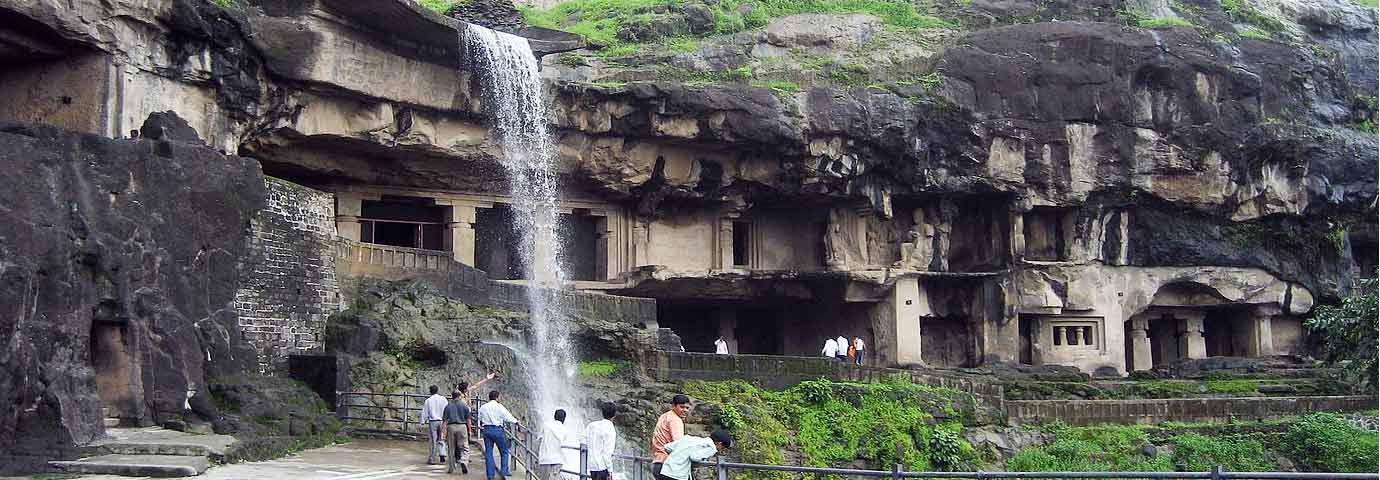Also known as Verul, Ellora is the name given to a group of Hindu, Buddhist and Jain caves dating back to 6th and 9th century and built during the reigns of Kalachuri, Rashtrakuta and Chalukya dynasties. The site of Ellora is located at a distance of approximately 30 kilometers north-northwest of Aurangabad, wherein lies the district’s headquarters.
Ellora incorporates in total 34 temples and monasteries and stretched over 2 kilometers, beautifully demonstrates the architectural and technological achievements of ancient India. The cave temples and monasteries are also an astonishing proof of inter-communal and inter-religious harmony, which was a celebrated characteristic of Indian society during the eras gone by.
History
Ellora caves are one of the most amazing and exceptional man-made structures to be carved out of such rugged and formidable rock systems which are peculiar of Deccan topography. According to archeological and geological surveys, the caves have been whittled out of rocks formed of basalt volcanic eruptions, which took place around 65 million years ago. Massive outburst and lava flows resulted in the formation of distinctive step like volcanic deposits, known as “Deccan Trap”.
The construction work at Ellora was started around 550 AD at the time the time when Buddhism was in its decline in India and Hinduism was again on the rise under the Chalukya and Rashtrakuta rulers. It is also at this time that the largest monolithic structure ever hewn out by man, the Kailasnath Temple was built. The last any such construction activity at Ellora was took place around 10th century AD, when the local rulers changed their allegiance from Hinduism to Digambara sect of Jainism.
What to See
The world heritage site of Ellora caves are made of impressive rock cut temples, forms carved out of formidable hills and several caves dedicated to different sects and cult of Hinduism, Buddhism and Jainism. All the structures at Ellora can be categorized into following different characters:
Temples
Kailasa Temple
Kailasa Temple or Kailasnath Temple is the central attraction at Ellora. The temple is largest such structure of its kind, hewed out of a single rock. According to historical chronicles, the construction of the temple took 7,000 laborers working through continuous hours and taking 150 years to complete. The temple, as the name suggests is dedicated to Lord Shiva and is a classic example of Dravadian Style of architecture with rigid proportions, detailed craftsmanship and elegant composition.
The courtyard is shaped in a U style with huge sculpted panels and structures of deities flanking its sides. As usual with Shiva Temples, there is an image of Nandi fronted by an image of Lingam in the courtyard. Besides, there are other forms showcasing Indian legendary icons and tales and exhibiting the astonishing artistry of Indian sculptors. The magnificent sculpture of Ravana trying to lift Mount Kailasa, with Shiva and Parvati sitting on the throne is an incredible milestone in Indian Art.
Caves
Caves at Ellora are of three kinds
-
Buddhist Caves: These are the earliest structures, constructed between 5th and 7th centuries. Most of these are monasteries, other structures and buildings like kitchen and living quarters carved out of hill-rocks.
-
Hindu Caves: The Hindu caves are a latter addition and were built at the start of 7th century. Some of these are pretty complex designs and showcases a noticeable vision, planning and execution.
-
The Jain Caves: The Jain caves are not as large as the other two but beautifully demonstrates minutes of Jain tradition and Philosophy. Some unusually intricate artwork is the characteristic of these caves.
How to Reach
By Air: The nearest airport to Ellora lies in Aurangabad which is located 15 kilometers away. Daily flights from Delhi and Mumbai arrive here while there is direct connectivity of airport with Jaipur, Pune and Udaipur as well.
By Rail: The nearest railway station is Aurangabad to which regular trains from Delhi, Hyderabad, Mumbai, and Amritsar etc. have a stopover. Besides there are a couple of daily trains that arrive to Aurangabad from Mumbai. Jalgaon is another suitable alternative to Aurangabad which is located 59 km from Ellora. Both of these stations are served by trains from all major cities of India.
By Road: The closest inter-state terminal is located in Aurangabad, which is situated at a distance of 30 kilometers from Ellora. Regular Autos ply from this terminus to Ellora or you can also catch private or Govt. run buses as well.


